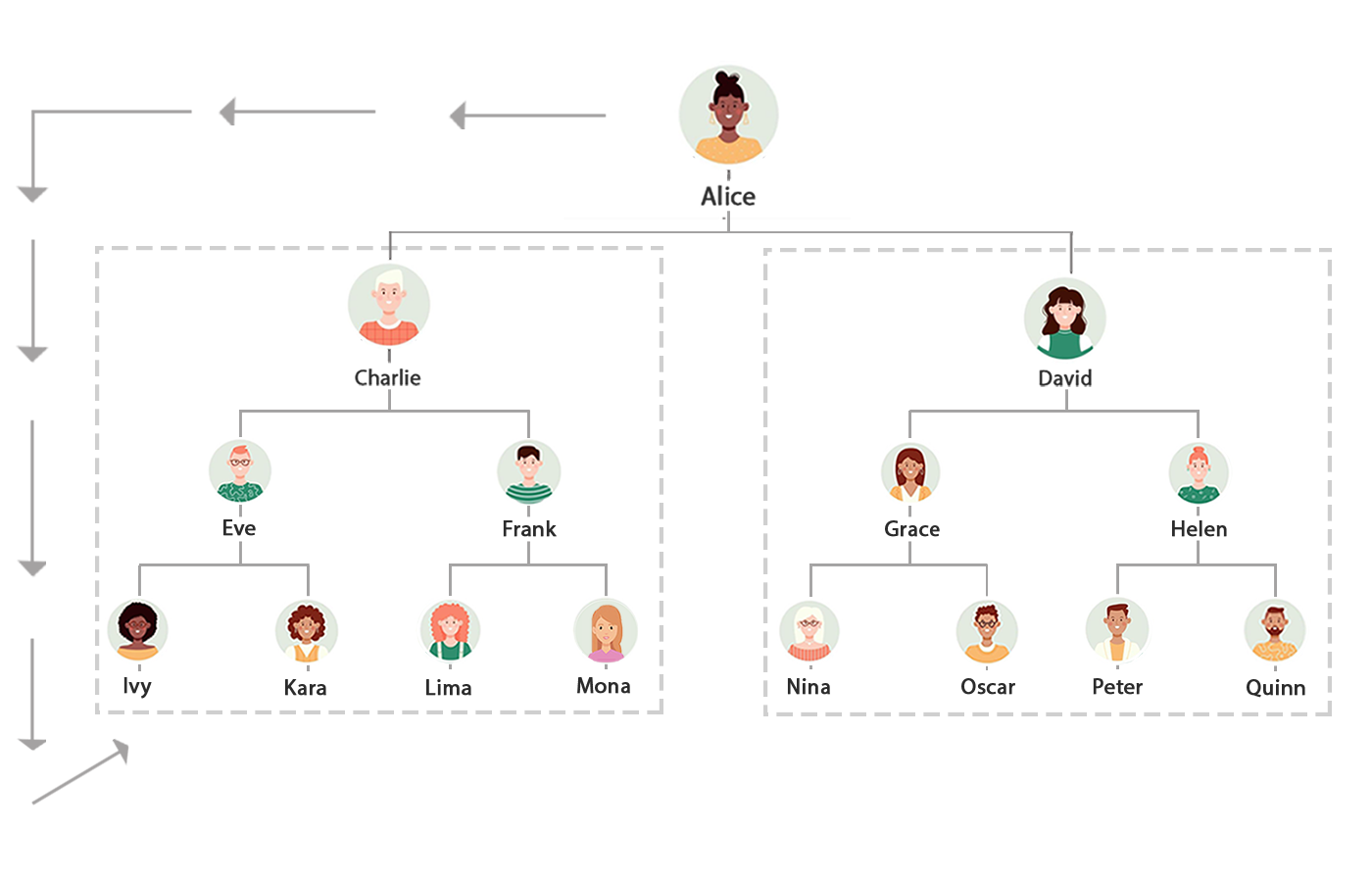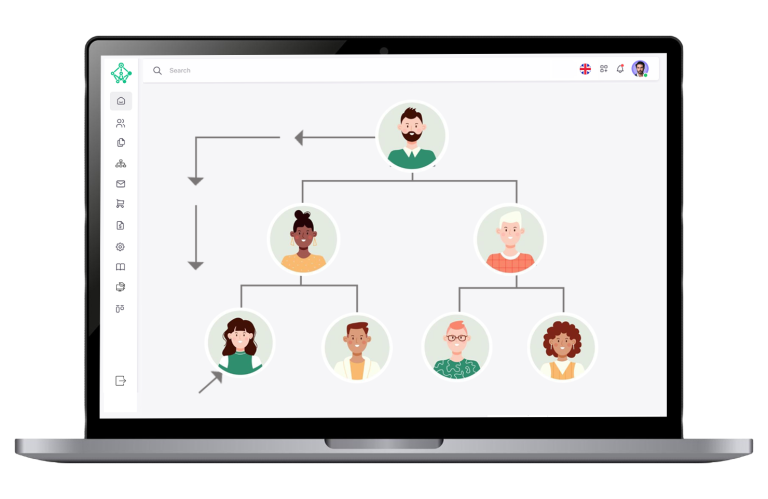How the Plan Works
In the Board MLM Plan, distributors progress through stages by filling boards or matrices with new recruits. Each board has a predefined structure, such as a 2×2 or 3×3 matrix, where distributors occupy positions as they enroll new members or benefit from spillover from their uplines. This plan fosters teamwork and collaboration as distributors work together to complete boards and advance.
Earnings are generated by completing boards, triggering advancement bonuses and other commissions. Distributors also benefit from re-entry into new boards, allowing continuous earning opportunities while maintaining growth within the network.
In this system, each board is named after the top user within it, such as “UserA’s Board” or “UserB’s Board.” As new users join, they are added to the board, filling it up over time. When the board reaches full capacity, a board completion event triggers, generating income for the top user of the board. This top user then has the opportunity for advancement. After the board is completed, the child of the top user receives new boards, and when new users join these boards, the process repeats. Essentially, whenever a new user joins, they wait for their turn to become the top user of the board, allowing them to receive the board completion income and continue the cycle.
Board Structure
In this system, there are different stages, each with its own board or matrix structure. For example, Stage 1 may have a 2×3 matrix, while Stage 2 could have a 2×2 matrix or another structure, depending on the company’s configuration. When a user joins, they are placed on the board of the first stage, which has the 2×3 matrix structure. As users fill the board and it completes, they move on to the next stage, where they join a board with a 2×2 matrix or a different structure, as defined by the company. The company has the flexibility to set the matrix structure for each stage and decide whether to use the same structure across stages or vary it according to their strategy.
Re-Entry
Normally, when a user completes a board in Stage 1, they have already earned all possible income from that board and are assigned a new position in the next stage, with no further earnings from the completed stage. However, reentry allows the user, upon moving to the next board, to also receive a new position in Stage 1. This enables the user to continue earning from Stage 1 while advancing through higher stages. By repeating this cycle, the user can keep earning from stage 1 and also upgrade through subsequent stages such as Stage 2, Stage 3, and beyond. As the new position in Stage 1 completes its board, it is promoted to the next stage, allowing the user to continue earning from that stage as well. This creates a continuous earning and progression cycle across stages.
Position filling and sponsor follow
When a user joins the system, the Sponsor Follow mechanism is typically applied, where the user is placed under their sponsor in the corresponding board. This ensures alignment with the sponsor’s board structure. While there is an option for Auto-filling, which assigns users to the next available position, the Sponsor Follow method is more commonly used. This mechanism also applies during promotions—when a user advances to the next stage, they are placed under their sponsor in the next board. Additionally, once a user completes all the boards, they can be re-entered into the first board through a process called Recycling, which is determined based on the company’s policies.
In some cases, Spillover may occur, where if a sponsor’s direct position is already filled, the system places the user in the next available position in the sponsor’s downline. This helps ensure that all positions in the structure are efficiently utilized while maintaining the overall alignment within the hierarchy.
Board View
Each board’s graphical representation is referred to as the Board View, which visually displays the structure and hierarchy of users within the board. A user can have entries across multiple stages and different boards, as well as multiple entries within the same stages due to re-entry. Users are provided with an option to view all the boards in which they currently have an active presence. Each board is assigned a unique Board Number, which is used to identify and differentiate between boards within the system. This structure ensures clarity and efficient management of user positions and board hierarchies.
Board Plan Explanation with Example
The Board Plan MLM system is a dynamic compensation model that promotes collaboration and progression through multiple stages of a matrix structure. Below is an example to illustrate its mechanics:
The system consists of 2 stages, each with a 2×3 matrix structure (two levels with three positions each). A user progresses through the stages by completing their matrix at the current stage.

Stage 1 Enrollment
Alice joins the Board Plan MLM system and is sponsored by Sophy. Alice is placed on Stage 1 under her sponsor’s matrix.
Alice then recruits Charlie and David, who are placed directly under Alice in the first level of Stage 1.
Matrix Filling and Spillover
Charlie recruits Eve and Frank, and David recruits Grace and Helen.
If Alice recruits another user (e.g., Ivy) after Level 1 is full, Ivy will be placed in the next vacant position on Level 2 under Eve. This process is known as the Spillover Effect.
Eve, Frank, Grace, and Helen continue recruiting, filling Level 3 as follows:
- Eve recruits Kara.
- Frank recruits Liam and Mona.
- Grace recruits Nina and Oscar.
- Helen recruits Peter and Quinn.
At this point, all three levels of Alice’s Stage 1 matrix are fully fille
Progression to Stage 2: Sponsor Follow
Once Alice’s Stage 1 matrix is complete, she is promoted to Stage 2. Alice is placed under her sponsor, Sophy, in Stage 2, contributing to the completion of Sophy’s Stage 2 matrix. This mechanism is known as the Sponsor Follow Effect, ensuring that each user progresses in alignment with their sponsor.
Board Splitting
When Alice completes Stage 1 and progresses to Stage 2, her Stage 1 board splits into two new boards:
– Charlie becomes the leader of one board.
– David becomes the leader of the other board.
Charlie and David now work to fill their respective Stage 1 boards. As they complete their boards, they also move to Stage 2 under Alice, following the Sponsor Follow Effect. This process continues for all users, ensuring ongoing network growth and progression.
Re-Entry
If the system includes a Re-Entry option, users can continue earning from Stage 1 even after progressing to higher stages.
When Alice completes her Stage 1 matrix and is promoted to Stage 2, a new position is created for her in Stage 1.
This re-entry position is placed in the next vacant spot on her original board, which, in this example, is under Ivy.
This new position acts like the original position, allowing Alice to recruit new members and earn bonuses. Over time, a single user can have multiple positions in various stages, maximizing their earning potential.
Re-Cycle
In models with a Re-Cycle feature, users can rejoin the system after completing all stages.
Upon completing the last stage, a user receives a new position in Stage 1, similar to a re-entry position.
This new position is placed in the next available spot, allowing the user to restart the process and contribute to the system’s growth.
Note: Re-Entry and Re-Cycle features are usually implemented separately, depending on the company’s business strategy.
Fees
Stage Entry Fees: Users pay an enrollment fee to join Stage 1 and additional upgrade fees to progress to higher stages. These fees generally increase with each stage.
Re-Entry Fees: When users benefit from re-entry, a fee is auto-debited from their wallet. This wallet is funded by board completion bonuses, ensuring a smooth and automated process for re-entry.
Customization: Advanced systems may offer optional upgrades or re-entry based on user preferences, providing flexibility to suit different business models.
Referral Bonus / Sponsor Bonus
In a Board MLM plan, Referral Bonus or Sponsor Bonus typically refers to a commission or bonus earned by a distributor when they personally sponsor (recruit) someone into the network. These bonuses are usually a one-time payout given to the sponsor for successfully enrolling a new member into the system
How it Works
- When Alice recruits a new distributor, she earns a Referral Bonus for sponsoring that person (for example, Charlie).
- The amount of the referral bonus may vary depending on the company’s compensation structure and could be a fixed amount or a percentage of the recruit’s initial purchase or enrollment fee.
Referral bonus amount
It may be a flat fee (e.g., $50) or a percentage of the enrollment or first purchase amount (e.g., 10% of Charlie’s initial purchase).
Example
Example 1: Alice recruits Charli into the Unilevel plan, and Charlie’s pays a $100 enrollment fee. Alice might receive a Referral Bonus of $20 (20% of Charlie’s fee) as a reward for bringing him into the system.
Purpose
- Referral Bonuses are intended to encourage distributors to actively recruit others into the MLM program and grow their network.
- These bonuses are typically structured to be more lucrative than ongoing commissions from deeper levels to provide immediate financial rewards for successful recruiting.
Board Completion Bonus
In the Board MLM Plan, the Board Completion Bonus is a reward distributed to members upon successfully completing their current stage and advancing to the next stage. This bonus serves as a milestone reward for achieving board completion and progressing through the system.
How it Works
Completing Stage 1
- When Alice’s Stage 1 board is fully completed, she is automatically promoted to Stage 2.
- Upon this promotion, Alice receives a Board Completion Bonus.
Advancing to Higher Stages
- Similarly, when Alice completes Stage 2 and progresses to Stage 3, she earns another Board Completion Bonus for completing her Stage 2 matrix.
Board Completion Bonus Amount
The Board Completion Bonus amounts are configured by the company and may vary based on the stage completed. Below is an example of typical amounts:
- Stage 1 Completion: $200
- Stage 2 Completion: $500
- Stage 3 Completion: Higher amounts, determined by the company’s compensation plan.
These bonuses are designed to increase as members progress to higher stages, reflecting the effort required to complete the boards.
Example
Stage 1 Completion:
- Alice completes her Stage 1 board and is promoted to Stage 2. She receives a $200 Board Completion Bonus for achieving this milestone.
Stage 2 completion
- After completing Stage 2, Alice progresses to Stage 3. She earns a $500 Board Completion Bonus, as configured by the company, for successfully finishing her Stage 2 matrix.
Purpose
The Board Completion Bonus is designed to:
- Recognize Achievements: Reward members for their efforts in completing a stage and advancing.
- Motivate Progression: Encourage members to work towards filling their board and progressing to higher stages.
- Incentivize Growth: Promote active engagement and participation across all stages of the matrix system.
Level Bonus
In the Board MLM Plan, the Level Bonus refers to the bonus earned by a member based on the joining of new members at various levels in their downline. This bonus is typically a fixed amount given when a new recruit joins the system under a member, with the bonus being distributed based on the level at which the recruit is placed.
How it Works
Level 1 Bonus
- When Alice’s direct recruits (Level 1) join the system, Alice earns a fixed bonus from their enrollment.
- The bonus for Level 1 is typically a flat amount since these are her direct recruits.
Level2 and Level3 Bonus
- As new recruits are placed under Alice’s downline, Alice earns a smaller bonus from the enrollment of new recruits at Level 2 and Level 3.
- The bonus for these levels is typically lower but still provides ongoing rewards as her downline grows.
Level Bonus Amount
The Level Bonus amounts are typically flat amounts based on the enrollment of new members at each level. The company configures these flat amounts based on its compensation structure. Below are some typical amounts:
- Level 1 Bonus: $20 per new recruit
- Level 2 Bonus: $10 per new recruit
- Level 3 Bonus: $5 per new recruit
These flat bonuses may vary depending on the company’s compensation plan and are designed to provide consistent rewards for each new recruit that joins the system under a member.
Example
Level 1 Bonus
- Alice recruits Charlie into the system. Alice earns $20 as a Level 1 bonus for Charlie’s enrollment.
Level 2 Bonus
- Charlie recruits David, and Alice earns $10 as a Level 2 bonus for David’s enrollment.
Purpose
The Level Bonus is designed to:
- Provide Ongoing Earnings: Reward members for the successful enrollment of new recruits at each level.
- Encourage Team Building: Motivate members to recruit and train others to build a strong, productive downline.
- Support Long-Term Growth: Provide financial incentives to members who help expand the network over time.




